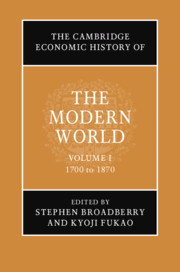Book contents
- The Cambridge Economic History of the Modern World
- The Cambridge Economic History of the Modern World
- The Cambridge Economic History of the Modern World
- Copyright page
- Contents
- Figures
- Tables
- Contributors to Volume I
- Preface and Acknowledgements
- Introduction to Volume I
- Part I Regional Developments
- 1 Britain, the Industrial Revolution, and Modern Economic Growth
- 2 Continental Europe
- 3 Tokugawa Japan and the Foundations of Modern Economic Growth in Asia
- 4 China: The Start of the Great Divergence
- 5 From the Mughals to the Raj: India 1700–1858
- 6 Sustainable Development in South East Asia
- 7 The Ottoman Empire, 1700–1870
- 8 The Economic History of North America, 1700–1870
- 9 Latin America: 1700–1870
- 10 Africa: Slavery and the World Economy, 1700–1870
- 11 Australia: Geography and Institutions
- Part II Factors Governing Differential Outcomes in the Global Economy
- Index
- References
9 - Latin America: 1700–1870
from Part I - Regional Developments
Published online by Cambridge University Press: 03 June 2021
- The Cambridge Economic History of the Modern World
- The Cambridge Economic History of the Modern World
- The Cambridge Economic History of the Modern World
- Copyright page
- Contents
- Figures
- Tables
- Contributors to Volume I
- Preface and Acknowledgements
- Introduction to Volume I
- Part I Regional Developments
- 1 Britain, the Industrial Revolution, and Modern Economic Growth
- 2 Continental Europe
- 3 Tokugawa Japan and the Foundations of Modern Economic Growth in Asia
- 4 China: The Start of the Great Divergence
- 5 From the Mughals to the Raj: India 1700–1858
- 6 Sustainable Development in South East Asia
- 7 The Ottoman Empire, 1700–1870
- 8 The Economic History of North America, 1700–1870
- 9 Latin America: 1700–1870
- 10 Africa: Slavery and the World Economy, 1700–1870
- 11 Australia: Geography and Institutions
- Part II Factors Governing Differential Outcomes in the Global Economy
- Index
- References
Summary
This chapter discusses the paths of Spanish and Lusophone America from the late colonial period through independence for most of Latin America to 1870. Relative continuity from colony to independent empire in Brazil contrasts sharply with regime change from colonial to republican systems in mainland Spanish America. Late colonial economies expanded significantly. Trading systems were transformed in the later eighteenth century; mining and slavery-based staple exports expanded fast, as did market integration within Latin America. Indicators of living standards show great diversity but paint a relatively positive picture until at least the last quarter of the eighteenth century. War and independence in the early nineteenth century knocked mainland Spanish America off its path of preindustrial expansion, while Brazil continued to expand. Rather than a ‘reversal of fortune’ new Spanish American republics faced the costs of a transition from a corporate political economy to an incipient republican one. It destroyed the fiscal basis of the state, led to increased concentration of landholdings, and dislocated goods and financial markets. Also, weak states failed to replace corporate structures of protections of the weaker social strata with individual access to legal protections. Regime change created opportunities for growth in the long run, but its immediate result was more inequality and falling living standards for significant parts of the population.
Keywords
- Type
- Chapter
- Information
- The Cambridge Economic History of the Modern World , pp. 219 - 245Publisher: Cambridge University PressPrint publication year: 2021

